This recipe for Tilor Pitha l Assamese style glutinous rice wrappers with a sweet sesame filling is full of nostalgia. This is a traditional Assamese (from Assam, a state in North East India) delicacy especially prepared during the festival of Bihu.

Bihu?
Assam, a North Eastern state of India, is primarily agricultural and three of its major festivals are all centred around it. Bihu is celebrated by all Assamese irrespective of religion, caste and creed. It has three forms-
- Kati or Kongali Bihu (which is observed in October, to pray for a good harvest)
- Magh or Bhogali Bihu (observed in January, to celebrate the end of the harvesting season)
- Bohag or Rongali Bihu (observed in April, the start of the cultivation season and to usher in spring and the Assamese New Year)

Magh / Bhogali Bihu-
Magh or Bhogali Bihu marks the end of the harvesting season. The granaries are full and there is a lot of feasting. Various rice and coconut based traditional snacks are prepared during this Bihu.
Magh Bihu is coming up in a few days time. A variety of delicacies called ‘pitha’ are made during this festival and most of the them are rice based. This tilor pitha is one of them and is unique to Assam. Unlike other pithas which are dough or batter based; the uniqueness of this pitha is that the outer wrapper is made with just ground rice. The stickiness of glutinous rice is depended upon to help hold its shape while rolling.

Memories-
As I stood in the kitchen and made these tilor pithas, it took me back decades to the one I grew up in. I saw myself beside my ma, mesmerised as she rolled one pitha after another with military precision. Unlike the mere 35-40 pithas that I made today, ma would probably make hundreds for us and other friends and family to enjoy. It was customary to serve pitha and other Bihu delicacies to guests who dropped by during this period.
I used the electric grinder to grind the rice. Back in Assam, when we were growing up, it was ground in the traditional grinder called ‘ural’. We had a heavy iron one. It had the shape of a cylinder and the mouth widened and thinned out at the top. A thick, long, and of course heavy iron log shaped ‘stick’ was used to pound the rice. During Bihu, our ural would be booked by our neighbours to prepare their own batches of pitha. I can still hear the cling-clang of the metal as the rice was pounded; I’ve done it so many times! In fact ma made sure that we all took turns in contributing towards the rice grinding.
When I was old and confident enough to make the pitha, I would share the pitha making responsibility with ma. She would start off, and I would make the second part.
Here in the UK, whenever Bihu knocks on the doorstep, I do make various traditional delicacies, but hadn’t made tilor pitha. Back home, it was prepared with a local sticky rice called ‘bora saul’. We do get glutinous rice here, but maybe it was the apprehension; the ‘what if’! I was good at making pitha; what if these do not hold their shape? What if the rice is not sticky enough? But finally, my love for the til pitha won and these pithas are the result. So, here I am, over the moon, and sharing my recipe with you.
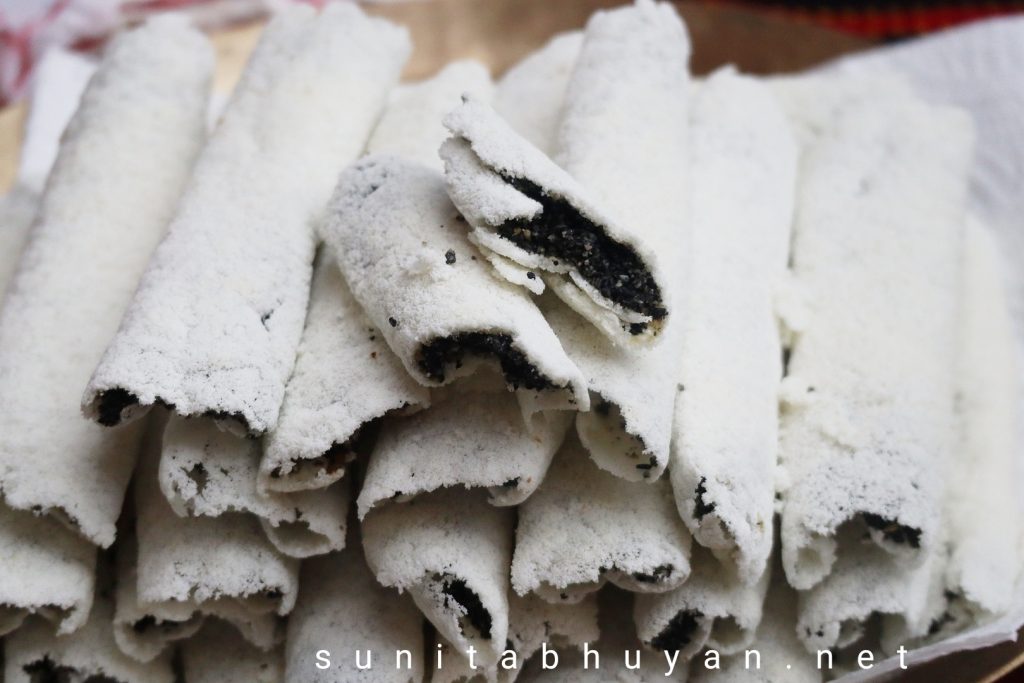
The rice wrapper is the trickiest part of making this pitha. So, one needs to keep a few things in mind. It gets easier with practice. You might find the following pointers helpful-
The rice-
I used regular glutinous rice from our local Asian grocery store. In Assam, the glutinous rice called ‘bora saul’ is used to make these pithas.
Soaking, straining the rice-
I washed and soaked the rice for about four hours. It was then transferred to a strainer and kept over a pot to drain off excess water. I made a dip in the middle of the rice and pushed the rice outwards. The rice was left on the strainer for about 4 hours as my strainer is narrow and deep. If yours is wider, you can keep it for fewer hours as the water will drain faster and rice will dry up sooner. We need the excess water to drain, but we do not want the rice to be dry. When you touch it, it should still feel wet, but not dripping.

Grinding the rice-
Grind small amounts in short bursts till you get the right consistency. Do not let the grinder become hot as it will affect the stickiness of the rice and make it difficult to roll the pithas.
Sieving the ground rice-
I did not sieve the ground rice. If you wish, you can.
Storing the ground rice-
Keep the ground rice in a clean, dry bowl and gently press it down. This prevents drying it out. Do not wait to do this until you have ground all the rice. So grind one batch, pat down in the bowl, grind another batch, pat down on top of previous batch and so on.
Refrigerate-
Cover the bowl of ground rice with cling film and refrigerate for 5-6 hours or overnight. Do not make the pitha immediately.

The griddle / tawa-
Use a heavy, thick bottomed iron pan to make the pitha. The thicker, the better as it will prevent the pitha from browning.
Heat-
The pan should be sufficiently heated, but not be to hot. You should be able to hold your hand a few inches (say 6-7 inches) over the pan without having to move it away. The pithas need to be cooked over low heat.
Making the pitha-
I have used a sieve to shape the rice wrapper; you can use a ladle to add the rice to the pan and shape them, or add a handful and shape with your fingers.

The filling-
I prefer the sesame flavour, so made the pitha with the traditional sweet sesame filling. My filling was not too sweet as we prefer it that way. Taste the filling before making the pitha and if you would like it sweeter, add more jaggery. A sweet coconut mixture is another traditional option used as the filling. Make sure the filling has cooled down before making the pithas.
Storing-
Let the pithas cool down completely before storing in an air tight container. They will be quite crumbly; handle with care.
Continue reading for the full recipe / video for tilor pitha l Assamese style glutinous rice wrappers with a sweet sesame filling.

Video-
Do check the instruction video on my YouTube channel (also embedded below) to see how I made these pithas.
All the Assamese recipes on this website can be found here.
You might also like to try the following recipes from this website-
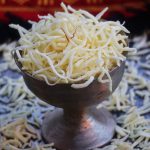
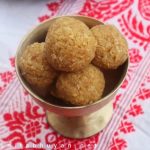

Subscribe to Sunita’s World – life and food! to receive updates on latest posts, tips and recommendations straight to your inbox! Simply fill in the details below. Thank you!
Stay connected-
On another note, if you try any recipe from this website, do take a photo and tag me on instagram @sunita_bhuyan. I would love to see your creations! Also, do connect on other socials too; links to all my socials are given below-
STAY CONNECTED:Recipe card-

Tilor Pitha l Assamese style glutinous rice wrappers with a sweet sesame filling
Ingredients
The outer wrapper-
- 3 cups glutinous rice
The filling-
- 1½ cups black sesame seeds
- 1½ cups jaggery shavings
- 1½ tbsp fennel seeds
Instructions
- Wash the rice in several changes of water until it runs clear. Soak the rice in enough water for 4 hours.
- Drain the water and leave the rice on a sieve for another four hours. Spread out the rice and make a dip in the middle to make it easier for the water to drain out. If your sieve is wider, you will need less time as the water will drain faster and rice will dry up sooner. We need the excess water to drain, but we do not want the rice to be dry. When you touch it, it should still feel wet, but not dripping.
- Grind the rice in small amounts and in short bursts till you get the right consistency. Scrape the insides of the grinding jar every now and then.Do not let the grinder become hot as it will affect the stickiness of the rice and make it difficult to roll the pithas.
- I did not sieve the ground rice. If you wish, you can.
- Keep the ground rice in a clean, dry bowl and gently press it down. This prevents drying it out. Do not wait to do this until you have ground all the rice. So grind one batch, pat down in the bowl, grind another batch, pat down on top of previous batch and so on.
- Cover the bowl of ground rice with cling film and refrigerate for 5-6 hours or overnight. Do not make the pitha immediately.
- In a small pan, add the sesame seeds and roast over low heat till it leaves an aroma and the seeds start to crackle. Transfer to a food processor and grind coarsely.
- Add the ground sesame seeds, jaggery and fennel seeds to a bowl and mix well, rubbing in with fingertips. There should be no huge lumps of jaggery. Keep aside and make sure the mixture has cooled before making the pithas.
- Place a heavy, thick bottomed iron pan/ tawa over low heat. The thicker the pan, the better as it will prevent the pitha from browning. The pan should be sufficiently heated, but not be too hot. You should be able to hold your hand a few inches (say 6-7 inches) over the pan without having to move it away. The pithas need to be cooked over low heat.
- From one side of the bowl, take a ladleful of the ground rice and place on a sieve.
- Using the sieve, spread the flour over the pan in an oval shape.
- Gently press with fingertips.
- After a couple of seconds, add a few teaspoonfuls of the filling across the middle.
- When the pitha starts to leave the pan ( the edges will start to come up and away from the pan), quickly make a roll from one of the longer ends. I just used my fingertips to start and finish making the roll. You can use the handle of a spoon etc to lift the edge to start rolling.
- After making the roll, push it to the edge of the pan to crisp up and get ready to make the next one. Do keep an eye on it; we don't it to brown.
- After shifting the pitha towards the edge of the pan use a tea towel to wipe away the remnants of the previous pitha and discard.
- Make the second pitha the same way as above.
- Make sure to keep an eye on the first (the one at the edge of the pan) or any others sitting near the edge. Turn it over and when it is crisp, transfer immediately to a dish lined with paper towels. Stack the pithas as you remove them from the pan.
- Make the rest of the pithas in the same way.
- Cool them completely before storing in an air tight container. They will be quite crumbly; handle with care.
Video
You might also like to try the following recipes from this website-
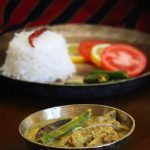
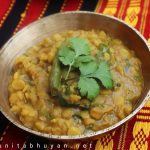

Until next time,
Sunita
STAY CONNECTED:


